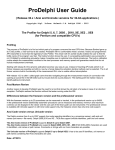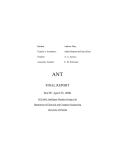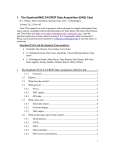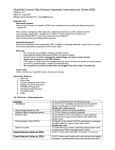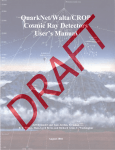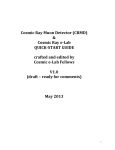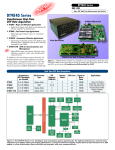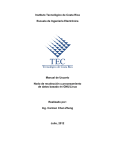Download Template for Final Paper - The Menlo Roundtable
Transcript
Applied Science Research
Dann
Christopher Rebert
5/10/08
Final Project Paper: Muon lifetimes
I. Abstract
In this project, the number of atmospheric muons was measured at day and night
using provided scintillators and a QuarkNet DAQ board. This entailed raw count
calibration, counter plateauing, and the creation of a Python program to more easily
interact with the QuarkNet board. Experimental results support the idea of solar muon
emission, with coincidence rates increasing until a noon peak of 62.64 Hz (when the Sun is
approximately overhead and closest to the Earth's surface) and then decreasing all the way
down to 32.46 Hz at 2AM the following morning with the Sun shining on the opposite side
of the Earth.
II. Motivation and History
Originally, I had intended to do an experiment proving relativity by showing a
discrepancy in the lifetimes of cosmic ray muons, which sounded particularly intriguing to
me.[1] It would also involve writing a program to communicate with the DAQ unit, and
being a programmer, this piqued my interest. However, once Dr. Dann had located the
exact paper outlining the experiment, we both concluded that it would not be feasible for a
high school student considering the limited time remaining in the course. However, having
already made significant progress on my computer program and finished initial calibration,
I decided to proceed with an alternate muon-related experiment. After consulting further
with Dr. Dann, it was decided that I would do a day-night comparison experiment, wherein
I would count the number of muons per hour during day and night and see if there was an
appreciable difference between the night and day numbers.
There have been a few fairly recent studies about atmospheric muon detection. In [2],
the experimenters used an underwater neutrino telescope and evaluated its performance as
well as that of their DAQ system. They also measured muon flux as a function of zenith
angle and found their data to be in line with previous measurements and predictions. [3]
was a similar experiment, measuring muon flux at the South Pole at 5 different zenith
angles using a unique scintillator compound. [4] examines muon flux at several altitudes
and uses the data to calculate the error in neutrino flux generated by a certain neutrino
interaction model, which they then go on to refine themselves. [5] uses cosmic ray energy
spectrum data from a balloon experiment to calculate cosmic ray muon flux at ground
level, and finds the results to be in keeping with those of similar experiments.
III. Theory of operation
To begin with, according to the Standard Model of particle physics, the muon
(symbol: μ) is an elementary particle with electric charge -1e and spin ½. It was discovered
by Carl D. Anderson, winner of the 1936 Nobel Prize in Physics, in 1936 at Caltech.[6]
When cosmic rays, high-energy particles from space, hit atoms in the atmosphere, they
react producing, among other things, pions, non-elementary particles that quickly decay
into muons and neutrinos via the following reaction:
π− → μ− + νμ
These muons then continue traveling along almost exactly the same path as their progenitor
pions. It is also theorized that the Sun could be producing muons as a result of its nuclear
reactions.[7]
When a muon hits a scintillator, the scintillator then absorbs the radiation and in
response fluoresces.[8] The light produced is then directed into a Photomultiplier Tube
(PMT). In the PMT, after being focused by a lens, the photons are converted into electrons
by a photocathode. These electrons go through a MicroChannel Plate (MCP), a plastic disc
with metal electrodes on each side and millions of microscopic holes in it. High-voltage
bursts that are constantly sent through the electrode pair accelerate the electrons through
the microchannels in the plate, causing cascaded secondary emission, drastically increasing
the number of electrons.[9]
These electrical impulses are then conveyed via Lemo signal cables to ports on the
QuarkNet DAQ board for processing . After being amplified by 10x, the signal is sent
through discriminators. The discriminators check whether the signal meets a specified
threshold level set by potentiometer. If it does, then this constitutes an incident and the
incident counter for that scintillator is incremented. And if at least a specified number of
incidents occur within a specified time interval, this constitutes a coincidence and the
coincidence counter is incremented. There are also 2 parameters, d and w, The incidence
and coincidence counts can then be read by computer over a serial cable connection.[10]
The interactive console-based Python[11] script communicates using the simple
ASCII-based commands defined in the user manual[10] while presenting a friendlier
menu-driven interface to users and not requiring them to know anything about the DAQ
board's command language. Note that the script should work on both Windows and unix
(including Mac) systems, but only Windows was used in this project due to the difficulty of
locating a Mac with a serial port or a serial port adapter. For further information on how the
script operates, see the heavily commented source in Appendix A.
IV. Design
Due to uncertainty as to their effect, d and w were left at their default values (d = 6 =
144ns, w = 10 = 240ns)[10] throughout the experiment. -0.3V was used as the threshold
voltage value throughout this experiment on the advice of Dr. Dann. All experiments took
place in the first-floor ASR classroom at Menlo School, approximately at ground level.
Before performing the day-night experiment, it is necessary to “plateau” the
scintillators. This is done in 2 steps: raw-count calibration and multiple counter plateauing.
Plateauing is needed to compensate for differing PMT gain and aging/degredation of the
scintillator material in order to get accurate data. Plateauing adjusts the PMT voltage so
that the data acquired contains a minimum of electronic noise and a maximum of real muon
interactions. If the voltage is set too high, then electronic noise will be heavily amplified
and give false positives. If the voltage is set too low, then the amount of data acquired will
be significantly decreased only high-energy muons will be detected while low or medium
energy muons will be ignored, resulting in the loss of legitimate data. In the multi-counter
plateauing step, the “flat” part of the graph is chosen as this indicates that one is detecting
most of the muons present with only minimum electronic noise and increasing the voltage
slightly is finding no additional muons. The edges of the graph go up and down
exponentially due to the cascading effect used by the PMTs.
For the raw count calibration, PMT voltage was varied and incidence counts were
taken at each voltage setting for ~45s. From this the incidence rate was calculated. The
scintillators were laid flat on a countertop with nothing on top of them so as to avoid any
extra muon shielding and expose maximum surface area to skyward muon detection. As a
muon incidence rate of 40Hz at ground level had been established as the accepted
value[12], the PMT voltage was set to the voltage setting which gave a reading closest to
40Hz until after counter plateauing was done.
For the plateauing experiment and the day-night experiment, the scintillators were
placed one on top of another in a “sandwich” configuration, with some wood blocks used
to space and stabilize them. Scintillator “D” was not used due to time constraints and only
3 scintillators being required for plateauing.
For ease of explanation in the plateauing experiment, let:
● 1 be the top scintillator
● 2 be the middle scintillator
● 3 be the bottom scintillator
In the plateauing experiment, 2-fold coincidences between 1 & 2 were counted for
~120s and then 2-fold coincidences between 1 & 3 were counter for ~120s. The ratio of the
frequency of the former over the frequency of the latter term is then calculated. This
process is then repeated for several PMT voltage values, and the frequency ratio vs. PMT
voltage is then plotted. The voltage where the graph is flattest is then the optimal value.
The scintillators are then repositioned appropriately and the entire process conducted again
to plateau the next scintillator until all of them have been plateaued.
In the day-night experiment, 2-fold coincidences between the scintillators were
counted and polled periodically throughout consecutive ~1-hour periods with the starting
and ending times of each period noted. Simple division yields average muon rates for each
1-hour period, which can then be plotted.
V. Results
The results of the initial scintillator calibration may be found in Tables 2-5 in
Appendix B and Figures 1-4 which follow.
Figure 1: Graph of scintillator “A” raw count data. Optimal voltage setting: 0.917V, which
gave reading of 40.18Hz
incidence frequency (Hz)
Scintillator A count rate (thresh = -0.3V)
200
180
160
140
120
100
80
60
40
20
0
0.85
0.9
0.95
1
1.05
1.1
1.15
PMT voltage (V)
Figure 2: Graph of scintillator “B” raw count data. Optimal voltage setting: 0.983V, which
gave reading of 39.83Hz
Scintillator B count rate (thresh = -0.3V)
incidence frequency (Hz )
120
100
80
60
40
20
0
0.85
0.90
0.95
1.00
1.05
1.10
1.15
PMT voltage (V)
Figure 3: Graph of scintillator “C” raw count data. Optimal voltage setting: 1.019V, which
gave a reading of 39.62Hz
scintillator C count rate (thresh = -0.3V)
incidence frequency (Hz)
80
70
60
50
40
30
20
10
0
0.850
0.900
0.950
1.000
1.050
1.100
1.150
PMT voltage (V)
Figure 4: Graph of scintillator “D” raw count data. Optimal voltage: 0.910V, which gave a
reading of 38.31Hz
Scintillator D count rate (thresh = -0.3V)
incidence frequency (Hz)
300
250
200
150
100
50
0
0.850
0.900
0.950
1.000
1.050
PMT voltage (V)
Data Table 1: Plateauing results for scintillator “A”
1.100
1.150
Voltage (V) Frequency ratio
0.729
0.00314
0.835
0.0192
0.947
0.860
0.951
0.928
0.957
1.02
0.970
1.13
1.106
1.42
1.120
987
1.140
7260
Data Table 2: Plateauing results for scintillator “B”
Voltage (V) Frequency ratio
0.737
0.00528
0.886
0.0344
0.976
0.941
0.982
0.973
1.003
0.986
1.062
1.108
1.119
1.242
1.360
769
1.429
8416
Data Table 3: Plateauing results for scintillator “C”
Voltage (V) Frequency ratio
0.754
0.00259
0.861
0.0385
0.972
0.969
0.989
0.981
1.089
1.09
1.154
1.26
1.189
1.48
1.359
747
1.412
4392
Unfortunately, I was unable to figure out how to create an Excel graph with a logarithmic
scale as is required for graphs of the plateauing data to be intelligible, but exponential
trends are clearly visible in the data, and based on [10], ratios closest to 1.0 indicate
optimal voltage. These voltages are summarized in Table 4.
Data Table 4: Optimum voltages for scintillators based on plateauing
Scintillator
A
B
C
Optimum voltage (V)
0.957
1.003
1.089
The following experimental results (Table 5 & Figure 5) from the day-night muon
detection experiment support the idea of solar muon emission because the muon
coincidence rates increased to a noon peak of 62.64 Hz (when the Sun is approximately
overhead and closest to the Earth's surface) and then decreased all the way down to 32.46
Hz at 2AM the following morning, with the Sun shining all the way on the opposite side of
the Earth. This correlation of Sun exposure and muon coincidences suggest that the Sun is
outputting muons, which are then detected when the Sun is visible thus increasing the
observed muon counts. However, as discussed in the Conclusion's error section, these data
do not prove definitively that the Sun is emitting muons.
Data Table 5: Data from day-night muon flux experiment
Time period
10:02:12AM – 11:00:07AM
11:00:15AM – 12:00:24PM
12:00:33PM – 01:00:38PM
01:00:47PM – 02:00:03PM
02:00:18PM – 03:00:23PM
03:00:40PM – 04:00:01PM
04:00:52PM – 05:00:29PM
05:00:37PM – 06:00:08PM
06:00:42PM – 07:00:31PM
07:00:56PM – 08:00:11PM
08:00:38PM – 09:00:21PM
09:00:32PM – 10:00:03PM
10:00:06PM – 11:00:55PM
11:01:09PM – 12:00:48AM
12:00:53AM – 01:00:40AM
01:01:13AM – 02:00:10AM
02:00:34AM – 03:00:36AM
Coincidence frequency (Hz) Time elapsed (s) Coincidences
54.71
3475
190128
59.22
3609
213731
62.64
3605
225815
60.42
3556
214867
57.36
3605
206781
53.28
3561
189733
48.16
3577
172257
49.83
3571
177949
48.25
3589
173156
43.56
3555
154839
41.32
3583
148041
38.07
3571
135934
39.79
3649
145194
35.89
3579
128468
34.56
3587
123982
32.46
3537
114813
33.91
3602
122142
Figure 5: Graph of day-night experiment data with error bars. Error calculated using
standard deviation. Hour values greater than 24 indicate times in the following day.
70.00
Coinc idenc e frequenc y (Hz)
60.00
50.00
40.00
30.00
20.00
10.00
0.00
8
10
12
14
16
18
20
22
24
26
28
Hour (24-hour clock)
VI. Conclusion
Overall, the project was a success though its solar muon results are not definitive.
The experimental results (Table 1 & Figure 5) support the idea of solar muon emission due
to the correlation between the distance between the Sun and the Earth's surface and the
observed muon coincidence rates, with a noon peak of 62.64 Hz and a minimum value of
only 32.46 Hz at 2AM the following morning, with the Sun facing roughly the other side of
the planet.
Error for the day-night experiment was calculated using standard deviation of the
coincidence frequencies, as shown in Figure X's error bars. Due to the magnitude of error
involved, approximately +/-10 on average, our conclusions regarding noticeable solar
muon activity are only probable, not certain, but the data does certainly seem to suggest
that the solar muon effect does exist. Error in this experiment could have been caused by
irregularities/aging of the scintillator material or PMTs, QuarkNet hardware malfunction,
programming error in the Python script, unexpected muon shower or other non-solar
fluctuation in natural muon emission, unknown shielding effects of the experiment site, or
unknown unnatural sources of muon emission rates. These could have caused the numbers
to be biased or entirely incorrect, though their coherency makes this less likely.
Over the course of the project, much was learned about interfacing with scientific
hardware as well as the particle physics involved in the experiments. Unfortunately, much
time was taken up by learning and trying to understand the somewhat arcane operation of
QuarkNet board, which left less time in which to perform the actual experiments.
Future work could include re-doing of the experiments for longer time periods to
further minimize error, calibration and plateauing of scintillator “D”, and enhancement of
the program produced including proper handling of the integer overflow of the QuarkNet
incidence and coincidence counters, and parsing of the live “data words” stream the board
makes available but was not utilized by this project. Unfinished code for the data words
processing is included in the quarknet.py source. Hopefully, future classes or projects can
build on the experience and tools gleaned from this experiment to do more interesting or
complex experiments.
VII. Bibliography
[1] Nichols A. Romero & Mukund T. Vengalattore, Speed and Decay of Cosmic Ray
Muons, Junior Physics Laboratory, Massachusetts Institute of Technology, 1998
[2] The NESTOR Collaboration (Aggouraset. al), A measurement of the cosmic-ray muon
flux with a module of the NESTOR neutrino telescope, Astroparticle Physics 23, p377–
392, 2005
[3] Bai et. al, Muon flux at the geographical South Pole, Astroparticle Physics, Volume 25,
Issue 6, p361-367, 7/2006
[4] Sanuki et. al, Atmospheric neutrino and muon fluxes, 29th International Cosmic Ray
Conference Pune 00, p101–104, 2005
[5] Ochanov, Calculation of the atmospheric muon flux motivated by the ATIC-2
experiment, 30th International Cosmic Ray Conference, 6/2007
[6] Wikipedia – The Free Encyclopedia, Muon, Wikimedia Foundation Inc.,
http://en.wikipedia.org/wiki/Muon, last modified 5/08/2008 3:14PM UTC
[7] Wikipedia – The Free Encyclopedia, Pions, Wikimedia Foundation Inc.,
http://en.wikipedia.org/wiki/Pions, last modified 3/23/2008 1:06PM UTC
[8] Wikipedia - The Free Encyclopedia, Scintillator, Wikimedia Foundation Inc.,
http://en.wikipedia.org/wiki/Scintillator, last modified 3/22/2008 10:13AM UTC
[9] Jeff Tyson, How Night Vision Works, Howstuffworks,
http://electronics.howstuffworks.com/nightvision.htm
[10] Rylander et. al, QuarkNet/Walta/CROP Cosmic Ray Detectors User's Manual,
08/2004
[11] Python programming language, version 2.5, Guido van Rossum et al., Python
Software Foundation, http://python.org, 4/2008
[12] Dr. James Dann, Applied Science Research class, Menlo School, Atherton, CA,
2007-2008
Acknowledgments
The author/experimenter would like to take this opportunity to thank:
● Dr. James Dann for coming up with the idea for this project and helping explain
some of the physics and electronics behind the experiment to me
● Jeff Rylander, Tom Jordan, R.J. Wilkes, Hans-Gerd Berns, Richard Gran, Fermilab,
and the University of Washington for writing the user's manual for QuarkNet
● the myriad of people who developed the QuarkNet data acquisition unit
● the Menlo School Technology Department for finding and letting me use their
serial cable and gender changer
● Chris Liechti, developer of the PySerial library which made writing my program
infinitely easier
● the Applied Science Research class of 2008 for providing me encouragement and
entertainment while I agonizingly waited for my program to gather data
Appendix A. - Python scripts
Please note that line-wrapping by the word processor may have slightly altered the
sources' whitespace.
quarknet.py – user-friendly console interface to the QuarkNet DAQ board
#!/usr/bin/env python
#Program to facilitate interaction with QuarkBoard
#Copyright 2008 Christopher V. Rebert
from __future__ import division
import serial
from time import sleep, time, strftime
from menulib import *
from sys import exit
from itertools import izip, chain, repeat
from time import time, sleep
from csv import writer
from os.path import exists
NEWLINE = '\r'#Quarkboard's newline char
PORT = None# serial connection to QuarkBoard
TRIGGER_PERIOD = -1#'d' in the manual
TMC_DELAY = -1#'w' in the manual
NS_PER_TICK = 24#tick = 24 nanoseconds
DATA = None #log file
DATA_DIR = "C:/Documents and Settings/MenloTech/Desktop/"#None #folder
to store logs in
DATA_EXT = ".csv" #extension of log files
OUTPUT = True
def writeln(s):
'''Write line of text to board with proper newline char'''
PORT.write(s + NEWLINE)
if False:##__debug__:
old_write = writeln
def new_write(s):
print
print "@@@", s
old_write(s)
writeln = new_write
def readline():
'''Read a line of output from the board'''
line = PORT.readline().strip()
if __debug__: pass ##print "GOT:", line
return line
BOARD_DELAY = 1#in seconds
def eatLine(n=1):
'''Retrieve and discard next output line from the board'''
for i in xrange(n):
sleep(BOARD_DELAY)#wait for board to catch up
readline()
def hexSans0x(n):
'''Returns string representing integer "n" in base 16 without
leading "0x"'''
return hex(n)[2:].upper()
##def _int2bin(n, bits=8):
##
'''Returns int "n" represented in binary as a string, using
"count" number of digits'''
##
return "".join([str((n >> y) & 1) for y in range(count-1, -1,
-1)])
##
##def hex2binDigits(hexNum):
##
#convert from hex to string of binary digits
##
#then reverse string so digits[n] is nth bit (n starts @ 0)
##
digits = ''.join(reversed(_int2bin(int(hexNum, 16))))
##
return digits
def binary2int(bin):
return int(''.join(reversed(bin)), 2)
#utility function from itertools recipes
def groupIn(n, iterable, padvalue=None):
"grouper(3, 'abcdefg', 'x') --> ('a','b','c'), ('d','e','f'),
('g','x','x')"
return list(izip(*[chain(iterable, repeat(padvalue, n-1))]*n))
def connect():
'''Connect to serial port QuarkBoard is connected to and output
connection details.
Returns opened PySerial serial.Serial object, or exits on
failure.'''
global PORT
print "Opening serial port...",
try:
PORT = serial.Serial(port=0, baudrate=19200, xonxoff=True)
except serial.SerialException, e:
print "failed"
print "Error while connecting:", e.message
print "Exiting on error!"
exit(1)
else: print "done"
print 'Connected on serial port #%s' %(PORT.port,)
##
print 'Baud rate:', PORT.baudrate
##
print 'Xon/Xoff enabled?:', PORT.xonxoff
##
print 'Timeout:', PORT.timeout,
##
if PORT.timeout is not None: print "seconds"
##
else: print
stopCounting()
VERIFICATION_GREETING = "Quarknet Scintillator Card"
EXTRA_GREETING_LINES = 3
RESET_DELAY = 1
def resetBoard():
'''Reset board to defaults. Also confirms that board is connected'''
if OUTPUT: print "Resetting board configuration to defaults..."
writeln("RE")
sleep(RESET_DELAY)
if VERIFICATION_GREETING not in readline():
if OUTPUT: print "failed"
raise IOError, "Card not connected (properly)"
#QUESTION: add 'SA 1' or 'SA 2' here???? try both ways
eatLine(EXTRA_GREETING_LINES)
if OUTPUT: print "done"
##def
##
##
##
##
##
disableCounters():
'''Disable coincidence counters'''
print "Disabling coincidence counters...",
writeln("CD")
eatLine()
print "done"
def enableCounters():
'''Re-enable coincidence counters and start displaying data lines'''
if OUTPUT: print "Enabling coincidence counters...",
writeln("CE")
eatLine(2)
if OUTPUT: print "done"
def setupChannels(fold, channels):#bit-twiddling has been checked to be
theoretically correct
'''Sets coincidence level and enables desired channels.
fold - int indicating coincidence level required
channels - list of bools specifying which channels on/off'''
if len(channels) != 4: raise ValueError, "On/off state not
specified for all channels"
if fold < 1 or fold > 4: raise ValueError, "Invalid # of channels
specified"
if OUTPUT: print "Enabling channels & setting coincidence level...",
leftChar = hexSans0x(fold - 1)
channels.reverse()
#convert channels from bools to ints (0 or 1)
#then combine into binary string, and convert that to hex
rightChar = hexSans0x(int(''.join([str(int(chan)) for chan in
channels]), 2))
writeln("WC 00 "+leftChar+rightChar)
eatLine(2)
if OUTPUT: print "done"
def stopCounting():
'''Stop incidence and coincidence counters.'''
global OUTPUT
if OUTPUT: print 'Stopping counters...',
oldOutput = OUTPUT
OUTPUT = False
setupChannels(4,[False]*4)
OUTPUT = oldOutput
if OUTPUT: print 'done'
def setTriggerPeriod(ticks):
'''Set (in ticks) how close time pulses must be to cause a
trigger'''
global TRIGGER_PERIOD
#period is difference between memory cells 01 and 02, so set cell
01 to 0
TRIGGER_PERIOD = ticks
if OUTPUT: print 'Setting trigger period ["d"]...',
writeln("WT 01 00")
eatLine(2)
writeln("WT 02 %s" % (hexSans0x(ticks).zfill(2),))
eatLine(2)
if OUTPUT: print "done"
def setGateWidth(ticks):
'''Set "gate width" ("w" in the board manual) to given value in
ticks'''
if OUTPUT: print 'Setting gate width ["w"]...',
TMC_DELAY = ticks
bits = hexSans0x(ticks).zfill(4)
#4 hex digit number split across 2 memory cells
writeln("WC 02 %s" % (bits[2:],))
eatLine(2)
writeln("WC 03 %s" % (bits[:2],))
eatLine(2)
if OUTPUT: print 'done'
class ScalerData(object):
'''Represents output of "DS" command'''
def __init__(self, scalers, coins):#, timeOverThresh):
self.scalers = scalers
self.coins = coins#coincidence count
#self.timeOver = timeOverThresh
def readScalers():
'''Return ScalerData obj representing output from "DS" cmd'''
if OUTPUT: print "Reading scaler values...",
writeln("DS")
eatLine()#eat echoing of cmd
pairs = readline().strip().split(' ')[1:]#split @ spaces, ignore
leading "DS" field
hexVals = [pair.split('=')[1] for pair in pairs]#grab hex number
from 'S1=846738'-like fields
scalers = [int(val, 16) for val in hexVals]#convert hex to integer
scalers.pop()#discard S5, the 1PPS signal, GPS-related
if OUTPUT: print 'done'
print 'Scaler values:', scalers
return ScalerData(scalers, scalers[4])
def prompt4chans():
'''Prompt user for coincidence and channel settings'''
channels = [ask4bool("Enable scintillator %s?" % i) for i in
xrange(4)]
nFold = ask4num("Detection fold to be considered a coincidence", 1,
4)
setupChannels(nFold, channels)
def prompt4period():
'''Prompt user for coincidence trigger period'''
setTriggerPeriod(ask4num('Period ["d"] for triggers to be
considered a coincidence [in %s ns ticks]' % NS_PER_TICK, 2))
def prompt4width():
'''Prompt user for gate width'''
setGateWidth(ask4num('Gate width ["w"]', TRIGGER_PERIOD - 1))
def terminal():
'''Gives user terminal-like access to board'''
connect()
print 'You now have terminal access to the Quarkboard.'
print 'Enter "end" to terminate the session.'
while True:
input = raw_input("QuarkNet> ")#get cmd from user
if input.lower() == 'end':
print 'Exiting...'
exit(0)
writeln(input)
sleep(1)
while PORT.inWaiting() > 0:#display output
print '========= ', readline()
def filename2logPath(filename, ext):
'''Generates full path to log file based on given filename'''
return DATA_DIR + filename + ext
def makeValidator(ext):
def _validator(name):
'''Checks whether a filename has already been used in the log
directory'''
path = filename2logPath(name, ext)
return not exists(path)
return _validator
def ask4aLog(prompt, ext):
'''Prompt user for log file name and return full path of desired
log file'''
return filename2logPath(ask4file(prompt, makeValidator(ext)), ext)
def prompt4log():
'''Prompt user for file to log to and open the file.'''
createLog(ask4aLog("Filename to log data to?", DATA_EXT))
def createLog(filepath):
'''Create log file or die on error'''
global DATA
if OUTPUT: print "Creating log file '%s'..." % filepath,
try:
DATA = file(filepath, 'w')
except EnvironmentError, err:
print
print "Error opening log file:", str(e)
print "Exiting on error..."
raise SystemExit
else:
if OUTPUT:
print "done"
print
print
##def log(line):
##
##
'''Write line to log file.'''
LOG.write(line+"\n")
##def parseEventLine(line):
##
fields = line.split(' ')[:9]#chop off GPS fields
##
log(','.join(fields))
##
#triggerCount = int(fields[0], 16)
##
#riseFalls = [(parseRise(rise), parseFall(fall)) for rise, fall
in groupIn(2, fields[1:])]
##
##def parseRise(hexVal):
##
bits = hex2binDigits(hexVal)
##
ticks = binary2int(bits[:5])
##
valid = bool(int(bits[5]))
##
newTrigger = bool(int(bits[7]))
##
##def parseFall(hexVal):
##
bits = hex2binDigits(hexVal)
##
ticks = binary2int(bits[:5])
##
valid = bool(int(bits[5]))
DEFAULT_D = 6
DEFAULT_W = 10
def calibrationExpmt():
##
f = file(ask4aLog("Filename to log incidents to?", ".csv"), 'wb')
w = writer(DATA)#f)
print 'Connect scintillator to QuarkBoard port #0.'
wait4user()
w.writerow(["scintillator", ask4str("Scintillator's designation")])
w.writerow(["trigger period [d] (ticks)", DEFAULT_D])
w.writerow(["gate window [w] (ticks)", DEFAULT_W])
fieldNames = ["voltage", "time (s)", "scaler", "scal freq (Hz)"]
w.writerow(fieldNames)
DURATION = ask4num("Duration of each run (sec)", kind=int)
print "Connect scintillator to be calibrated to port #0."
wait4user()
try:
while True:
connect()
v = ask4num("Scintillator voltage (V)?", kind=float)
setTriggerPeriod(DEFAULT_D)
setGateWidth(DEFAULT_W)
init = _ask4boardValue()
print "***Gathering data. This will take ~"+str(DURATION),
"seconds...***"
prevOutput = OUTPUT
OUTPUT = False
start = time()
setupChannels(1, [True] + 3*[False])
sleep(DURATION)
s = readScalers()
end = time()
print "***Data gathered!***"
OUTPUT = True
scal = s.scalers[0] - init
##
c = s.coins
duration = end-start
freq = scal/duration
row = [v, duration, scal, freq]
print "Incidence frequency:", freq, "Hz"
w.writerow(row)
PORT.close()
if ask4bool("Done with this scintillator?"): break
print "Power-cycle the QuarkBoard."
print "Also, change the voltage setting on the scintillator
being calibrated."
wait4user()
DATA.flush()
finally:
DATA.close()
exit(0)
def _ask4counter(prompt):
'''Asks the user for a number corresponding to a port #.'''
return ask4num(prompt, mini=0,maxi=3,kind=int)
def coincidenceCount():
return readScalers().coins
def _runCoinExpmt(chans, PLATEAU_DURATION):
global OUTPUT
connect()
setTriggerPeriod(6)
setGateWidth(10)
offset = coincidenceCount()
print "***Gathering datum. Please wait", '~'+str(PLATEAU_DURATION),
"seconds...***"
oldOutput = OUTPUT
OUTPUT = False
start = time()
setupChannels(2, chans)
sleep(PLATEAU_DURATION)
coins = readScalers().coins - offset
PORT.close()
end = time()
OUTPUT = oldOutput
print "***Done gathering datum***"
elapsed = end - start
freq = coins / elapsed
return freq
ALL_OFF = [False]*4
def _1plateauDatum(top, mid, bot, PLATEAU_DURATION):
print "*****Gathering datapoint...*****"
first = ALL_OFF[:]
first[top] = first[mid] = True
second = ALL_OFF[:]
second[top] = second[bot] = True
numer = _runCoinExpmt(first, PLATEAU_DURATION)
print "Power-cycle the QuarkBoard."
wait4user()
denom = _runCoinExpmt(second, PLATEAU_DURATION)
ratio = numer / denom
print "*****Datapoint calculated*****"
print "Coincidence frequency ratio:", ratio
return ratio
def plateauExpmt():
PLATEAU_DURATION = ask4num("Duration of one plateauing experiment
run (sec)", mini=0, kind=float)
plateaued = 1
top = 0
bot = 2
print 'Connect 3 scintillators in a "sandwich" configuration as
follows:'
print 'Top: scintillator connected to port #%s' % top
print 'Middle: scintillator to be plateaued, connected to port #%s'
% plateaued
print 'Bottom: scintillator connected to port #%s' % bot
wait4user()
##
f = file(ask4aLog("Log file to output plateauing data to?",
'.csv'), 'w')
log = writer(DATA)
log.writerow(["Scintillator voltage (V)", "Coincidence frequency
ratio"])
while True:
v = ask4num("Scintillator #%s voltage (V)?" % plateaued,
kind=float)
freq = _1plateauDatum(top, plateaued, bot, PLATEAU_DURATION)
log.writerow([v, freq])
DATA.flush()
if ask4bool("Done plateauing?"): break
DATA.close()
def dayNight():
setupParameters()
nPeriods = ask4num("Number of periods?")
duration = ask4num("Duration of periods (min)?", mini=2)*60
delay = ask4num("Time to wait before beginning experiment (sec)?")
w = writer(DATA)
w.writerow(["start", "end", "elapsed (s)", "coincidences",
"frequency (Hz)"])
DATA.flush()
base = time()
doneInit = time()
delay -= doneInit - base
sleep(delay)
for i in xrange(nPeriods):
togo = duration
oldcount = 0
total = 0
start = time()
while togo > 0:
count = coincidenceCount()
if count < oldcount:
total += oldcount
oldcount = count
sleep(60)
togo -= 60
end = time()
total += count
elapsed = end-start
w.writerow([strftime(start), strftime(end), elapsed, total,
total/elapsed])
DATA.flush()
DATA.close()
def prompt4DataDir():
global DATA_DIR
DATA_DIR = ask4dir("Log & data directory")
def setupParameters():
connect()
prompt4log()
prompt4period()
prompt4width()
prompt4chans()
ACTIVITIES = (("Calibrate scintillator",calibrationExpmt),
("Terminal interface to Quarkboard",terminal),
("Plateau scintillator",plateauExpmt),
("Perform day-night solar muon experiment",dayNight))
try:
#prompt4logDir()
prompt4log()
ask4choice("Choose activity", ACTIVITIES)()
finally:
print "Goodbye!"
print "Closing port...",
try: PORT.close()
except: pass
print "done"
print "Closing log file...",
try: LOG.close()
except: pass
print "done"
menulib.py – simple console-based menu-driven user interface library
from os.path import isdir
from string import ascii_letters as _LETTERS, digits as _DIGITS
_ACCEPTABLE = set(_LETTERS + _DIGITS + '_- ')
del _LETTERS, _DIGITS
def ask4bool(question):
'''Asks the user a yes/no question. Returns a bool indicating their
response.'''
question += ": "
while True:
input = raw_input(question).lower()
if input in ('yes', 'y'): return True
elif input in ('no', 'n'): return False
print "Invalid input. Must be either (y)es or (n)o."
def ask4num(question, mini=None, maxi=None, kind=int):
'''Asks the user for an integer within the given range.'''
rng = ''.join(('(', str(mini) if mini is not None else '', '-',
str(maxi) if maxi is not None else '', ')'))
mid = " " + rng
if mini is None and maxi is None:
mid = ""
prompt = question + mid + ": "
while True:
try:
s = raw_input(prompt)
if s != '0': s = s.lstrip('0')
val = kind(s)
except ValueError: print "Invalid input. Must be a valid
decimal number."
if (maxi is not None and val > maxi) or (mini is not None and
val < mini):
print "Invalid input. Not within valid range %s." % rng
else: return val
def ask4str(question, validator=None, errMsg="Try again."):
'''Asks the user for a string for which "validator" returns True.'''
question += ": "
error = "Invalid input. "+errMsg
while True:
input = raw_input(question)
if validator and not validator(input): print error
else: return input
def wait4user():
'''Does not return until user acknowledges the program'''
raw_input("Press Enter to continue")
print
print
def _validateFilename(name):
'''Check that proposed filename contains only valid characters.
Allowed chars are letters, digits, underscores, dashes, and
spaces.'''
for char in name:
if char not in _ACCEPTABLE:
return False
return True
_BAD_FILENAME_MSG = "Filename must contain only letters, digits,
underscores, dashes, or spaces, and must not already be in use."
def ask4file(prompt, validator):
'''Asks the user for a filename that passes _validateFilename and
the given "validator"'''
def validater(s): return _validateFilename(s) and validator(s)
return ask4str(prompt, validater, _BAD_FILENAME_MSG)
def ask4choice(prompt, titleValPairs):
'''Asks the user to choose an option from a list.'''
prompt += ":"
while True:
print prompt
print '='*(len(prompt)+2)
for i, titleVal in enumerate(titleValPairs):
title = titleVal[0]
print "[%s]"%(i+1), title
print
try:
choice = int(raw_input("Enter the number of your choice:
")) - 1
if choice > i or choice < 0: raise ValueError
except:
print "Invalid input. Try again"
wait4user()
continue
else: break
print
print
return titleValPairs[choice][1]
def ask4dir(prompt):
'''Asks the user for an existing directory.'''
prompt += ': '
while True:
path = raw_input(prompt)
if isdir(path): return path
print "Directory does not exist. Try again."
wait4user()
Appendix B. - Raw count data
Data Table 2: Raw count calibration data for scintillator “A”
Voltage (V)
0.867
0.878
0.889
0.902
0.917
0.921
0.931
0.940
0.951
1.109
incidence frequency (Hz)
incidence count time (s)
26.19
1258
48.03
30.40
1460
48.03
32.69
1570
48.03
36.62
1759
48.03
40.18
1930
48.03
42.24
2029
48.03
50.86
2443
48.03
51.13
2456
48.03
55.86
2683
48.03
187.02
8983
48.03
Data Table 3: Raw count calibration data for scintillator “B”
Voltage (V)
0.908
0.920
0.931
0.940
0.952
0.960
0.970
0.983
0.984
0.985
0.993
1.003
1.105
incidence frequency (Hz)
incidence count time (s)
20.51
985
48.03
22.90
1100
48.03
24.48
1176
48.03
27.32
1312
48.03
31.98
1536
48.03
31.92
1533
48.03
36.50
1753
48.03
39.83
1913
48.03
42.39
2036
48.03
41.94
2015
48.05
46.43
2230
48.03
48.28
2319
48.03
100.39
4822
48.03
Data Table 4: Raw count calibration data for scintillator “C”
Voltage (V)
0.910
0.921
0.935
0.945
0.950
0.963
0.973
0.982
0.995
1.019
1.110
incidence frequency (Hz)
incidence count time (s)
16.76
805
48.03
17.30
831
48.03
19.86
954
48.03
19.92
957
48.05
21.57
1036
48.03
23.26
1117
48.03
25.09
1205
48.03
27.79
1335
48.03
30.42
1461
48.03
39.62
1903
48.03
73.18
3515
48.03
Data Table 5: Raw count calibration data for scintillator “D”
Voltage (V)
0.892
0.902
0.910
0.914
0.925
0.942
0.953
0.964
0.975
1.100
incidence frequency (Hz)
incidence count time (s)
33.85
1627
48.06
36.02
1734
48.14
38.31
1840
48.03
42.22
2030
48.08
45.37
2179
48.03
53.19
2559
48.11
56.78
2730
48.08
63.79
3071
48.14
76.75
3691
48.09
252.96
12150
48.03






















